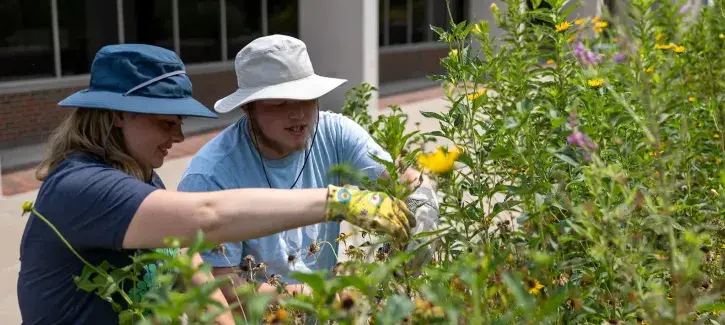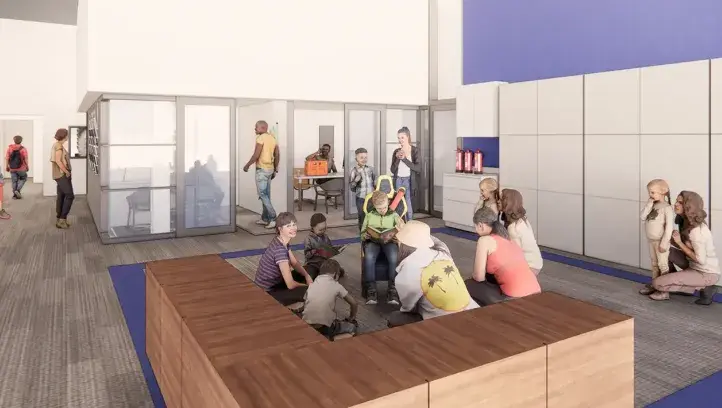
Creighton’s path to sustainability: Where hope meets innovation

With its Sustainable Creighton Initiative, the University seeks to meet “the needs and aspirations of the present, without compromising the ability of future generations to do the same” (1987 UN “Our Common Future” report) while also remaining true to our Catholic, Jesuit mission in giving the Creighton family reasons to be optimistic about the future of our common home–Earth.
“It’s about instilling authentic hope in our students, faculty, staff and alumni for a future where they are inspired to take action, embrace creativity and innovation and build connections within their community. It’s about seeing real progress toward protecting clean air, healthy soil and fresh water, while cultivating a sense of purpose and ownership in caring for our common home,” says Andrew Baruth, PhD, director of the Office of Sustainability Programs at Creighton.
The phrase “common home” comes from Pope Francis’ landmark teaching document on the environment, Laudato Si’, in which he asserts that “climate change is a global problem with grave implications,” especially for poor and developing countries that suffer disproportionately compared to wealthier developed nations.
Which makes sustainability more than a nicety. Viewed in this light, it is part of the Catholic Social Teaching canon, and thus a moral imperative. “Catholic Social Teaching stresses that care for God’s creation is essential to Christian faith because we find God in all things, creation has intrinsic value and ecological degradation violates human dignity and solidarity, particularly among the poor, honorable and marginalized, whom we are especially called to love,” says Dan DiLeo, PhD, theologian, associate professor and director of Justice and Peace Studies and member of Creighton’s Sustainability Governance Committee.
Citing the Association of Jesuit Colleges and Universities’ Laudato Si’ Commission recommendations, DiLeo says, “Jesuit universities are called to make and prioritize funding for comprehensive science-based decarbonization commitments” and thus fulfill the Jesuits’ third Apostolic Preference “to build a ‘hope-filled future,’ because authentic hope only comes from action that matches the scope and urgency of a problem.”
Creighton’s sustainability timeline: A recent account
The University’s approach to sustainability was formalized in 2013 with the Climate Action Plan.
In 2016 and 2017, Richard Miller, PhD, Mary Ann Vinton, PhD, and Jay Leighter, PhD, worked with students and administrators to establish the Presidential Advisory Committee on Sustainability, Office of Sustainability Programs and Planetary Emergency Lecture Series.
In 2020, more than 70 students, faculty and staff formed a collection of Action Teams to address Creighton’s Climate Change Task Force.
After 18 months of research and discernment, they formulated what is now the Sustainable Creighton Initiative, updating the 2013 plan to incorporate academic action and engagement in addition to operational improvements.
In early 2022, the task force shared the revised and augmented plan with University leadership. With clearly outlined goals, an understanding of budgetary implications and its alignment with then-science-based targets from the Intergovernmental Panel on Climate Change (IPCC), the Sustainable Creighton Initiative was approved and presented to the campus, fittingly enough, on Earth Day 2022.
Sustainability policies and initiatives: An overview
“We quickly realized that providing ‘authentic hope’ required us to also address key issues, like greenhouse gases, through updates in our operations. We also needed to be more intentional academically by growing the number of sustainability-related courses and action opportunities students experience; offer new engagement strategies, such as Eco-Reps, new waste diversion options, certifications programs and tours; and faithfully report our sustainability progress,” Baruth says.
What needed to happen was more than a “feel-good” or band-aid approach centered on saving a little money here or increasing efficiency there.
Currently, one in seven courses discuss sustainability and development, as defined by the United Nations, alongside traditional course content. Within the freshman-level course, The Christian Tradition, undergraduates discuss challenges in the contemporary world, challenges that include ecological concerns.
“We now have a sustainability-related course attribute,” Baruth continues, “with the goal to get to 90% of departments to have at least one of these courses in their curriculum.”
New certificate programs, such as the Sustainable Creighton Office Certificate, invite employees to engage in simple and straightforward, but powerfully impactful, ways. These programs help promote sustainability as an opportunity to be intentional about consumption, and not merely limiting choices.
It’s a paradigm shift that resonates—to date, 29 offices have been recognized with Sustainable Creighton Office Certificates for completing more than 16 sustainable actions pertaining to waste reduction, engagement, efficiency, purchasing, transportation and printing.
“My peers at other institutions marvel at our ability to maneuver with administrative support, recognizing that this makes sustainability the duty of our entire community and not just our single sustainability office or a few passionate individuals,” Baruth says.
Cumulative effect of small (and not so small) acts: Big wins, and recognition
From composting to construction, Creighton seeks to be intentional in its sustainability efforts. “Intentional” means it doesn’t happen by chance. It’s the result of desire mixed with thoughtful action. And it comes in both large and small ways.
For instance, swapping compostable or reuseable service ware – silverware, napkins, plates, etc. – in campus dining facilities and at catered events—a “small” shift—has had a profound cumulative effect. Through composting, less than 10% of waste ends up in a landfill for many campus events. Or, per the University’s “Swag Guide,” asking three questions—Is it essential? Is it useful? Is it durable?—before choosing swag for an event or program reduces the chance that swag will quickly find its way into a landfill.
An example of larger scale success is how environmental stewardship shapes campus infrastructure growth. Here, innovation and intentionality work in tandem. Solar features in Graves Hall provide carbon-free electricity and domestic hot water heating. The new sophomore residence’s climate control system uses geothermal energy, storing and absorbing heat from up to 450 feet underground in 186 wells. Older existing buildings are systematically retrocommissioned to make them more efficient.
The result of these collective efforts is Creighton has reduced its carbon footprint by 40%—without buying carbon offsets from off-campus projects.
The Association for the Advancement of Sustainability in Higher Education (AASHE) has recognized these efforts, awarding Creighton the Silver STARS (Sustainability Tracking, Assessment and Rating System) ranking in 2023. The campus is on target to earn the Gold ranking in 2026, a fast-track advancement.
As an institution of higher learning, Creighton by nature is in the business of providing hope, Baruth maintains. And the Sustainable Creighton Initiative is “a useful and essential vessel to help steward that hope.”
It’s the people behind the plan that give the latter its legs. “Every small moment reinforces the agency we all have in shaping our shared bright future,” Baruth says.




